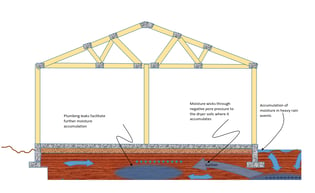So you have a recommendation to pressure grout the soils to stabilize them for a structure of some sort, usually a building that is on top of the unstable soils. It seems that there is a lot of smoke and mirrors when it comes to the grouting world. Over the next few posts, it is my goal to share all of the inside information to remove the smoke and mirrors.
What are the various forms of soil stabilization accomplished with pressure grouting?
- Compaction Grouting: Soil stabilization by low mobility grout that is usually cement based. This is low slump with a specific gradation in the mix designed to increase shear of the particles that keep it from following and traveling in weaknesses in the soil. This type of pressure grouting if done properly will create solid round bulbs in the soil that will compact the soil between injection points. It will usually have the added bonus of creating columns of support. In order to be successful it will need to be injected into the soils with casing between 2 and 3 inches in diameter. The pressure at the head is usually between 100 and 700 psi.
- Intrusion grouting: This is done with a thinner type of grout. It is usually more effective in rocky soils where the goal is to seek out voids and fill them. There can be risk of the grout traveling to places you don’t want it to such as conduits, pipes. This can be injected with smaller casing and lower pressures.
- Permeation grouting: This type of grout is with super thin grout. It is used to flow between existing soil particles to and fill microscopic voids. It creates a matrix similar to concrete or mortar using the existing soil as aggregates. This can be done with pipe (casing) as small as 1” diameter and usually pressures lower than 100 psi. This many times is done with tube-a-manchettes, a double pipe system with one pipe inside of the other.
- Slab Jacking AKA Mud Jacking: The process of lifting a concrete slab by injecting grout under the slab and using hydraulic pressure to do the lifting.
- Chemical grouting: This is usually done with polyurethanes. When injected it is a very low viscosity and then as the material reacts it then foams up to a calculated density. Much of the time this is done as a water proofing technique. The other common use for this is slab jacking.
- Undersealing: This is the grouting under a slab to fill a void without raising. This is done with a low viscosity grout that flows very easily. Careful monitoring of the slab will inform the grouter to stop as soon as the slab starts to show slight movement.
The point I am making is that we see ourselves primarily in providing innovative solutions to meet challenging problems that our clients present to us. So we have adjusted our name to more accurately reflect our primary core of providing solutions to foundation problems.
Because we also do large amount of commercial new construction and alterations, we felt that foundation repair did not encompass all of these types of services and that foundation solutions did encompass these services. So finally we bit the bullet and made the change. Hope you like it. Feel free to contact me and give me your thoughts.
Each of these techniques will have great results for applications specific for its use. Grouters and engineers with the proper experience know when the right time to use these techniques to achieve great cost effective results. By using a specific technique in the wrong application, an unsatisfactory and sometimes disastrous outcome is realized. If property owners or engineers are unfamiliar with these techniques and their proper applications, leaving it up the contractor, then many times the contractor will use the technique that they are experienced or familiar with resulting in less than optimal results.
Over the next few posts I will write more detail on each of these techniques, their pros, cons, applications, and important things to know to properly manage your grouting contractor. There are other techniques such as fracture grouting that are not commonly used that I won’t spend much time on. I will also try to show the drawbacks and dangers of using the various techniques in the wrong application. Here is a hint. If your engineer is telling you that the technique used for a specific application is to be solely determined by the contractor, your engineer does not have the experience to be helpful. Pressure grouting is not a black art. It is a science that can be measured and controlled with consensus guidelines. As a matter of fact the ASCE and the Geo institute have developed a grouting guide with some of the best grouting engineers and professionals in the country. They have performed hundreds of field tests and determined what techniques give the best results in each specific soil condition. You can buy the guide from the ASCE Website at http://www.asce.org/Product.aspx?id=2147488284 for $75.00. I highly recommend it for anyone involved in the grouting industry.






